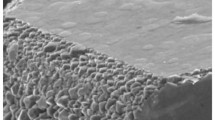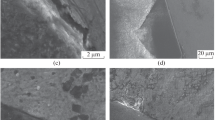Abstract
Diamond composites with nanocrystalline cubic silicon carbide bonding were sintered from diamond/amorphous silicon mixtures under high pressure and high temperature (p = 5 GPa and temperatures up to 1673 K). Differential scanning calorimetry, ex situ x-ray, and Raman spectroscopy investigations showed that amorphous silicon partially transformed into nanocrystalline silicon at 873 K under 5 GPa. This was followed by the formation of nanocrystalline silicon carbide from the reaction between the silicon and diamond after silicon melting. Refinement of the x-ray diffraction patterns of composites with the Rietveld method revealed that considerable microstrain (0.3–0.5%) remained within the nanocrystalline silicon carbide grains. Small strain (0.1–0.2%) was observed in the compacted diamonds, but after the reaction they became almost strain free (<0.1%). Enhanced fracture toughness was obtained for hybrid composites compared to liquid-infiltrated composites.
Similar content being viewed by others
References
P.N. Tomlinson, N.J. Pipkin, A. Lammer, and R.P. Burnand, Indust. Diamond Rev. 6, 299 (1985).
W. Tillmann, Int. J. Refractory Metal & Hard Mater. 18, 301 (2000).
I.E. Clark and P.A. Bex, Indust. Diamond Rev. 1, 43 (1999).
X. Jiang and C.P. Klages, Appl. Phys. Lett. 61, 1629 (1992).
G.A. Voronin, High Pressure Sintering of Diamond-and CBNbased Composite Materials by Infiltration: Main Stages and Regularities, edited by M. Nakahara (International Conference on High Pressure Science and Technology, Kyoto, Japan, 1997), p. 467.
Y.S. Ko, T. Tsurumi, O. Fukunaga, and T. Yano, J. Mater. Sci. 36, 469 (2001).
A.E. Ringwood, Australia Patent No. 601561 (1988).
S.K. Gordeev, S.G. Zhukov, L.V. Danchukova, and T.C. Ekstrom, Inorg. Mater. 37, 579 (2001).
A.A. Shulzhenko, V.G. Gargin, A.A. Bochechka, G.S. Oleinik, and N.V. Danilenko, J. Superhard Mater. 22, 1 (2000).
S. Veprek, J. Vac. Sci. Technol. A 17, 2401 (1999).
R.A. Andrievski, Int. J. Refractory Metal Hard Mater. 19, 447 (2001).
E.A. Ekimov, A.G. Gavriliuk, B. Palosz, S. Gierlotka, P. Dluzewski, E. Tatianin, Yu. Kluev, A.M. Naletov, and A. Presz, Appl. Phys. Lett. 77, 954 (2000).
G.A. Voronin, T.W. Zerda, J. Qian, Y. Zhao, D. He, and S.N. Dub (unpublished).
A. Witek, B. Palosz, S. Stelmakh, S. Geirlotka, R. Pielaszek, E. Ekimov, V. Filonenko, A. Gavriliuk, and V. Gryaznov, in High Pressure Materials Research, edited by R.M. Wentzcovich, R.J. Hemley, W.J. Nellis, and P.Y. Yu (Mater. Res. Soc. Symp. Proc. 499, Warrendale, PA, 1998), p. 115.
J. Qian, G. Voronin, T.W. Zerda, D. He, Y. Zhao, J. Mater. Res. 17, 2153 (2002).
T.D. Shen, C.C. Koch, T.L. McCormick, R.J. Nemanich, J.Y. Huang, J.G. Huang, J. Mater. Res. 10, 139 (1995).
E.P. Donovan, F. Spaepen, D. Turnbull, J.M. Poate, and D.C. Jacobson, Appl. Phys. Lett. 42, 698 (1983).
C.J. Howard, J. Appl. Crystallogr. 15, 615 (1982).
A.C. Larson and R.B. Von Dreele, General Structure Analysis System (GSAS) manual (Los Alamos National Laboratory, NM), pp. 159–166.
T. Ungar and A. Borbely, Nanostruct. Mater. 11, 103 (1999).
J.H. Kim and J.Y. Lee, J. Appl. Phys. 77, 95 (1995).
G. Morell, R.S. Katiyar, S.Z. Weisz, and I. Balberg, J. Non-Cryst. Solids 194, 78 (1996).
D.W. Feldman, J.H. Parker, Jr., W.J. Choyke, and L. Patrick, Phys. Rev. 173, 787 (1968).
C. Pantea, J. Gubicza, T. Ungar, G. Voronin, and T.W. Zerda, Phys, Rev. B 66, 094106 (2002).
G.A. Voronin, C. Pantea, T.W. Zerda, and K. Ejsmont, J. Appl. Phys. 90, 5933 (2001).
B. Palosz, S. Gierlotka, S. Stel’makh, R. Pielaszek, P. Zinn, M. Winzenick, U. Bismayer, H. Boysen, J. Alloys Compd. 286, 184 (1999).
J. Zhang, L. Wang, D.J. Weidner, T. Uchida, J. Xu, Am. Mineral. 87, 1005 (2002).
Author information
Authors and Affiliations
Corresponding author
Rights and permissions
About this article
Cite this article
Qian, J., Zerda, T.W., He, D. et al. Micron diamond composites with nanocrystalline silicon carbide bonding. Journal of Materials Research 18, 1173–1178 (2003). https://doi.org/10.1557/JMR.2003.0161
Received:
Accepted:
Published:
Issue Date:
DOI: https://doi.org/10.1557/JMR.2003.0161




